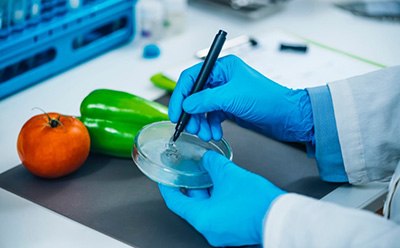The Perfect Recipe?
Your dedication to food and beverage safety.
Food and Beverage Safety Heroes
We understand the vital role you play in bringing food to the world's table and we are committed to supporting you at every stage of the food testing workflow. As a worldwide leading provider of life science solutions, we offer trusted, intuitive products and services for lab efficiency and regulatory compliance, backed by technical expertise and quality systems.
With recent advances in the food industry, production, accessibility, and trends of food have evolved to accommodate global needs. Most of all, the safety and quality of food are of utmost importance.
We support food & beverage testing heroes by:
- Partnering with leading global scientists to ensure access to the gold-standard food and beverage products of today and tomorrow. Working alongside leading experts enables us to develop innovative solutions that meet the unique needs of the food and beverage industry. Discover related products.
- Providing dependable, connected, and rapid solutions that are specifically tailored to the needs of the food and beverage industry. Our solutions are designed to streamline the testing process, increase efficiency, and reduce errors for optimal results.
- Offering a broad and complete portfolio with high-quality solutions throughout the entire safety testing workflow.
Workflow
Sample Preparation

Chemical Sample Analysis

Microbiology Sample Analysis

Request More Information
We care about food & beverage safety as much as you do and are committed to advancing global food safety and quality together with our customers, regulators, and consumers through our chemistry and microbiology solutions.
For additional information on our products, services, and solutions for food & beverage testing or to be contacted by a technical sales specialist for discussions or quotes, please complete and submit the form below.
Fields indicated by an * are required.
How is our relationship with, and our expectation of food changing? Watch this video:
Current Challenges and Solutions
Testing needs in food and beverages are changing constantly, as a result of increasing environmental impacts, modernization and a focus on sustainable ways to feed a growing population. Our regulatory and market experts work alongside you to ensure you have the methods to solve tomorrow’s challenges today.
Microbial & Chemical APPLICATION & TESTING SUPPORT
As a food and beverage quality control worker, you face constant changes in testing needs due to increasing environmental impacts, modernization, and a growing focus on sustainable ways to feed a growing population. We understand the importance of staying ahead of tomorrow's challenges and working alongside you to provide innovative solutions.
One of the key challenges facing the industry is meeting environmental goals, and we can help you achieve this through sustainable products and packaging solutions. Our regulatory and market experts are also available to ensure that you comply with industry regulations.
When it comes to food safety, microbial testing is critical, and we offer a range of products that comply with international standards. These include dehydrated and granulated culture media, ready-to-use agar plates, liquid media, and molecular or immunological solutions for detecting pathogens like Listeria, Salmonella, Campylobacter, E. coli, or quality indicator organisms.
We also provide solutions for spoilage testing for beverages, hygiene monitoring, and contaminant analysis. Chemical food safety analysis and quality control are also crucial for ensuring the safety, quality, and nutritional value of products. Our products are designed to test for allergens, harmful pesticide residues, heavy metals, mycotoxins, veterinary drug residues, and other contaminants.
Our products include solutions for Aflatoxins and Mycotoxins, disinfection control, heavy metals, food fraud, and authenticity. We also offer sugar analysis solutions for reflectometry and HPLC methods.
We understand that accuracy, precision, and consistency are essential in food and beverage testing, and we aim to provide innovative products that match your high standards.
Contact us to find out how we can help you meet the challenges of food and beverage testing today and tomorrow.

Food Pathogen & Spoilage Detection
When it comes to food and beverage safety, microbial testing is critical, and we offer a range of innovative products that comply with international standards for rapid and reliable results for pathogen, spoilage and hygiene testing. These include dehydrated and granulated culture media, ready-to-use agar plates, liquid media, and molecular (PCR) or immunological solutions for detecting pathogens like Listeria, Salmonella, Campylobacter, E. coli, or STEC. or quality indicator organisms that can enhance the effectiveness of your environmental monitoring practices

Food and Beverage Contaminant Analysis
Chemical food safety analysis and quality control are implemented to test for safety, quality, and nutritional value, allowing for the safe consumption of products free of allergens, harmful pesticide residues, heavy metals, mycotoxins, and veterinary drug residues. Thus, we understand the importance of sourcing analytical products that match your high standards for food and beverage products to ensure accurate, precise, and consistent results.

Services & Regulatory Support
We offer expert guidance and support to help food and beverage manufacturers and testing labs navigate the ever-changing landscape of quality control, method development and safety regulations. Our team of experienced professionals can provide customized solutions tailored to your specific needs, and help you optimize your microbial QC testing practices for enhanced safety and quality control. Complying with food and beverage regulations can be a complex process, and it's important to prioritize the safety of both staff and consumers. Determining the best methods for compliance can be challenging, but we're here to help.
Contact us to discuss the optimal solutions for your food and beverage testing and analysis
Related Resources
- Food & Beverage Safety Brochure: Microbial QC Solutions
Discover efficient workflows and reliable testing solutions designed to enhance quality control in the food and beverage industry.
- Flyer: Infographic on Alternative Protein Quality Testing
Explore our infographic on alternative protein testing, highlighting methodologies and standards for sustainable food safety.
- Brochure: Beverage Safety Testing
The brochure outlines our extensive beverage safety analysis and details a comprehensive range of high-quality products, reliable testing solutions, and services for your beverage analysis workflow.
- Brochure: Safe Solutions For Food
When it comes to determining food quality and ensuring food safety, sample preparation is key for rapid and precise analysis. This brochure details various workflow solutions and best-in-class products that suit your testing needs.
- Compendium: Analytix Reporter Special Food & Beverage
Special edition of the Analytix Reporter with over 30 application notes focused on food and beverage safety. It includes articles on topics such as food allergens, mycotoxins, and pesticide residues, as well as information on new products and technologies for food safety testing.
- Brochure: Detecting Heavy Metals
Routine high sensitivity testing of toxic metals is essential in the food supply chain. Learn about key testing solutions and workflows for detecting heavy metals to ensure the food safety and compliance.
- Brochure: Sustainability and Milli-Q® Lab Water Solutions
From decreasing water and energy consumption to minimizing plastic and chemical waste, Milli-Q® water purification systems are designed to reduce their ecological footprint, to better support your sustainability goals.
To continue reading please sign in or create an account.
Don't Have An Account?